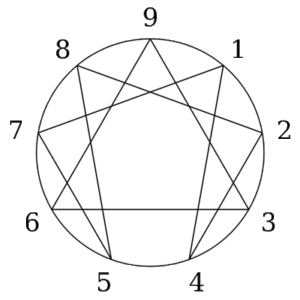It has been a while since I’ve written about the enneagram, a model of nine personality profiles and three instincts. But since finishing William M. Schafer’s Roaming Free Inside the Cage: A Daoist Approach to the Enneagram and Spiritual Formation, I thought I’d share his perspective on the subject.
As noted in an earlier post, there are lots of books, websites, blog posts, podcasts, and articles on the subject, along with variations on how each pundit embraces the teachings of the enneagram. For the sake of brevity, here are descriptors that I use to capture the nine types:
 The Perfectionist (a.k.a. Reformer or Idealist)
The Perfectionist (a.k.a. Reformer or Idealist)- The Connector (a.k.a. Helper or Giver)
- The Performer (a.k.a. Achiever or Motivator)
- The Individualist (a.k.a. Romantic or Sensitive Soul)
- The Observer (a.k.a. Thinker or Investigator)
- The Security Seeker (a.k.a. Planner or Loyal Skeptic)
- The Enthusiast (a.k.a. Epicure or Generalist)
- The Protector (a.k.a. Challenger or Commander)
- The Peacemaker (a.k.a. Mediator or Team Player)
Schafer suggests a need to study the enneagram to integrate and balance our differentiated parts and reclaim our essential qualities. We begin life in wholeness. Infancy provides an experience of pure presence, joy, wonder, curiosity, interest, and awareness of others’ awareness. Three shocks encumber our bliss:
- Loss of wholeness upon birth as we enter the physical world
- Loss of emotional connection when relationships prove variable
- Loss of trust when caregivers fall short of our needs and expectations
These shocks disturb the natural balance of energies: yin as retractive, passive, and receptive, and yang as active, assertive, repelling, and expansive. In a struggle to survive, our egos either give undue to weight to their yin or yang energies, or hold too tightly to a balance between them. Personality forms around this energetic imbalance.
- A yin person manifests a lack of edge and aggression. They have a soft, resting energy that either draws us in or demands that we lose energy in order to connect. [Types 4, 5, 9]
- A yang person moves out with power, force, or intensity. We may feel taken aback by them. [Types 3, 7, 8]
- A reconciling person neither invites nor overwhelms. In an attempt to preserve both yin and yang, they keep their energy contained. They may be hard to read. [Types 1, 2, 6]
Each type also has a distinctive emotional energy that reflects a distorted view of a holy ideal and virtue. Rather than resting freely in the bounty of its innate endowment, the type develops habits to suppress experiences it deems unacceptable. The more skillful the avoidance, the greater the barrier to personal and spiritual growth.
| Type | Holy Ideal | Virtue | Avoidance |
| 1 | Perfection | Perfection | Error, anger |
| 2 | Freedom, will | Humility | Personal need |
| 3 | Law, harmony, hope | Veracity | Failure |
| 4 | Origin | Equanimity | Ordinary living |
| 5 | Omniscience | Non-attachment | Emptiness |
| 6 | Strength, faith | Courage | Spontaneity |
| 7 | Work, plan, wisdom | Constancy | Boredom, pain |
| 8 | Truth | Innocence | Vulnerability |
| 9 | Love | Right action | Conflict |
Schafer views the enneagram as a means to reclaim all the initial stages of wholeness. Working with the enneagram challenges us to invite sensations, feelings, and states of mind that we otherwise consciously avoid. Knowing one’s type is less important than inquiring within about the energies and processes that motivate behavior. We are encouraged to be observant, compassionate, nonjudgmental, and accepting in the journey. This approach provides a doorway to consciousness so that we can live freely within our types.
The next three posts will provide a deeper dive on Schafer’s teachings regarding the nine types of the enneagram. They are organized by triads, with each triad containing representations in:
- The three centers of intelligence: Body (instinctive), Heart (feeling), and Head (thinking)
- The three great life forces – Receptive (yin), Active (yang), and Balancing (yin/yang)
- The three forms of emotional regulation: Positive Outlook (a.k.a. Reframing), Reactive (a.k.a. Expressive), and Competency (a.k.a., Containing)
Stay tuned!